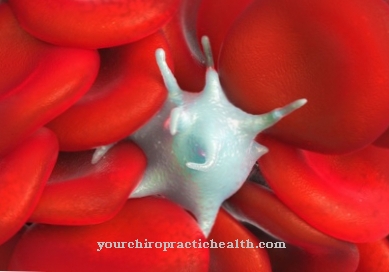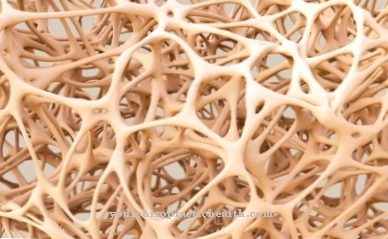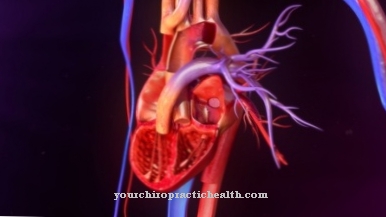In the retrograde peristalsis it is a muscle movement of hollow organs such as the esophagus, stomach, intestines, ureters, uterus and fallopian tubes. During this movement, they actively transport their content against the physiological direction. The retrograde peristalsis has a protective function and occurs physiologically in the intestine to store stool.
What is retrograde peristalsis?

With retrograde peristalsis, medicine describes a specific transport movement of the esophagus, stomach, large intestine or ureter, as well as uterus or fallopian tubes in women. Anatomy calls these structures hollow organs, as they do not form a continuous compact cell mass and instead comprise an interior space. This cavity is also known as the lumen; a skin-like covering tissue (epithelium) covers the inside of the cavity, while smooth muscles are located in the outer layers.
In peristalsis, these muscles contract, forcing the contents of the hollow organ to move in a certain direction. Nerves of the autonomic nervous system control the smooth muscles that humans cannot control at will.
Medicine also calls transport in the normal direction orthograde peristalsis. The retrograde peristalsis, on the other hand, describes the transport in the opposite direction and therefore bears the name Anti-peristalsis.
Function & task
Smooth muscles surround hollow organs. Its name is reminiscent of the flat surface of the muscles: it lacks the transverse muscle strips that are characteristic of the striated muscles. Compared to her, smooth muscles use less energy and oxygen, but work more slowly.
The parasympathetic nervous system controls the retrograde peristalsis. The parasympathetic nervous system is a part of the autonomic nervous system. It controls involuntary processes that cannot be set in motion or interrupted by the individual willingly. These processes are highly automated and therefore only require very little capacity of the brain. Activation of the sympathetic nervous system, the activating part of the nervous system, usually inhibits peristalsis.
But the parasympathetic nervous system is not solely responsible for the retrograde peristalsis: In the stomach and ureter, in particular, the organs' own reflexes also trigger the transport movement. In peristalsis, the smooth muscles of a hollow organ contract in a ring, thereby narrowing the lumen. The constriction forces the contents to move in a certain direction - in retrograde peristalsis, against the physiological direction. The contraction continues in the direction of transport and thereby pushes the contents of the hollow organ piece by piece in the desired direction.
The retrograde peristalsis of the esophagus and stomach is mainly used when vomiting. The esophagus actively transports the chyme so as not to block it. It can also remove small residues from the esophagus. This way, the esophagus protects itself from irritation and serious damage from stomach acid. Any remaining food particles also pose a potential risk of infection.
In the small and large intestines, peristalsis transports the intestinal contents to the rectum in a physiological direction. However, the movements of the colon are not continuous; they occur in phases. A healthy person's digestive system goes through one to three such exercise periods per day. Their number depends on various factors, such as the physical activity of the person or the amount of fiber in the diet.
Retrograde peristalsis allows the colon to temporarily store stool. It is not only triggered by the parasympathetic nervous system, but also by the local peristaltic reflex of the intestine.
In women, peristalsis is used to move the egg cell in the fallopian tube. Furthermore, the peristalsis of the uterus supports the breakdown and removal of the mucous membrane during menstruation. It also plays an important role in the birth process.
You can find your medication here
➔ Medicines against vomiting and nauseaIllnesses & ailments
Normally, peristalsis of the large intestine leads to up to three bowel movements per day, depending on physical activity, dietary fiber content, consumption of intestinal stimulating substances and other factors. In addition, psychogenic influences also play a role in the frequency of peristalsis. The medicine speaks of constipation (constipation) when the bowel empties less than once in three days. Common symptoms of constipation include Pain in the lower abdomen, unnatural feeling of fullness, pressure and movement-dependent pain, flatulence and the impression of incomplete emptying during bowel movements.
Long-term constipation poses a risk for various reasons: The stool can physiologically clog the intestine and in extreme cases completely occlude the intestine; the intestinal walls can suffer mechanical damage and even tear from hardened stool. In such a case there is a risk of excrement getting into the abdominal cavity, in which there are numerous organs. Penetrating bacteria and contamination can then cause infections that can affect both the tissue between the organs and the organs themselves. The retrograde peristalsis of the colon can prevent this to some extent.
The retrograde peristalsis of the stomach also has a protective function. When a person ingests potentially toxic substances, the body can initiate a number of reflexes and involuntary reactions. The organism can induce vomiting via the gag reflex and anti-peristalsis. The muscles of the stomach contract and reduce the volume of the stomach so much that its contents push out. The contraction of the esophageal muscles also helps transport possible toxins out of the body. The active transport movement is even more important than with orthograde peristalsis, as it has to transport the chyme against the normal direction as well as against gravity.












.jpg)



.jpg)










.jpg)
